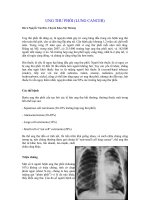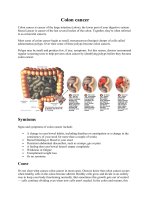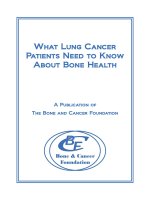FOR PATIENTS LUNG CANCER pdf
Bạn đang xem bản rút gọn của tài liệu. Xem và tải ngay bản đầy đủ của tài liệu tại đây (706.02 KB, 50 trang )
Scottish Intercollegiate Guidelines Network
S I G N
lung
cancer
for patients
for patients
© Scottish Intercollegiate Guidelines Network
ISBN 978 1 905813 10 0
First published 2007
SIGN consents to the photocopying of this booklet for the
purpose of implementation in NHSScotland
1
2 What is this booklet about?
3 What is lung cancer?
5 Symptoms and diagnosis
11 What happens if I have lung cancer?
17 What treatment will I need?
19 Treatment for small cell lung cancer
21 Treatment for non-small cell lung cancer
24 Other treatments for lung cancer
27 Will I receive palliative care?
28 What will happen after my treatment is
finished?
29 What if I smoke?
31 Support and help
39 Glossary
42 Space for your notes
2
What is this booklet about?
This booklet is for you if:
you are worried that you may have lung cancer; or
you have already been diagnosed with lung cancer.
Your family, friends and carers may also find it useful.
It is based on the recommendations from a national clinical
guideline on how to look after patients with lung cancer.
It explains:
what lung cancer is;
what the symptoms are;
how it is diagnosed; and
how it is treated.
We have listed details of support organisations, where you
can get more information at the end of the booklet.
We have explained the medical terms used in this booklet
on page 39,
3
What is lung cancer?
Lung cancer happens when the cells in your lungs start to
grow in an uncontrolled way and form tumours. Tumours
are lumps of tissue made up of abnormal cells.
There are two main types of lung cancer.
Small cell lung cancer (a type of cancer made up of
small round cells in the lungs).
Non-small cell lung cancer (cancer which grows in cells
other than small cells inside the lungs).
These two types of lung cancer develop differently and are
also treated differently. You can find out more about how
they can be treated on pages 19 and 21.
Sometimes lung cancer can spread to other parts of your
body. Cancer cells can break away from the tumour in your
lung and travel around your body in your blood or lymphatic
system. The cancer cells can travel to other organs and
grow into what are called secondary cancers.
Large
airways
Lungs
Windpipe
4
5
Symptoms and diagnosis
What are the symptoms of lung cancer?
The symptoms of lung cancer can include:
coughing up blood;
a persistent cough;
breathlessness;
wheezing;
hoarseness;
chest or shoulder pain;
tiredness; and
weight loss.
You may only experience one or two of these symptoms.
Since we all may experience these symptoms from time to
time, it can sometimes be difficult for your GP to diagnose
lung cancer.
If you have had any of these symptoms for more than
three weeks and your GP does not know why, they should
arrange for you to have a chest X-ray at hospital to check
for signs of lung cancer.
6
If you have been coughing up blood and your GP can find
no obvious reason for this, they should refer you to hospital
for a chest X-ray as soon as possible.
You can ask the person doing the X-ray how long you are
likely to wait for the results of your chest X-ray.
What if my doctor thinks I have lung cancer?
If your GP suspects that you have lung cancer after seeing
the results of your chest X-ray, he or she will arrange for
you to be seen at the hospital by a chest doctor (consultant
respiratory physician). This doctor will do some more tests
to check if you have lung cancer. Your GP can give you
an idea of how long you are likely to wait to see a chest
doctor. Ideally, this should be within two weeks.
7
Your GP should refer you to a chest doctor, without waiting
to see your X-ray results, if you:
are older than 40 and a smoker or ex-smoker and you
are coughing up blood;
have a swollen neck or face; or
have severe breathing problems.
This will be a difficult time for you and your family. You
may have many questions. Your GP and other healthcare
staff can offer you support and can answer any questions
you may have. They can listen to your concerns and should
give you information about diagnosis, tests and treatments.
This may include:
giving you information leaflets such as this one;
arranging for other healthcare staff to give you
information; and
giving you details of websites that give information and
support.
What tests will I have at hospital?
First you will have an ordinary X-ray and a longer X-ray
called a computed tomography (CT) scan. The CT scan
takes a series of X-rays to build up a picture of your lungs.
These will show your doctors and healthcare team if there
are any parts of your lungs that do not look normal. The CT
scan will not be able to tell if the cause is lung cancer.
8
If the doctor thinks that you might have lung cancer, they
will take a sample of tissue from your lung. This is called a
biopsy. There are different ways of doing this, depending
on which part of your lung the biopsy is taken from. The
doctors will send this tissue sample to the laboratory to
be looked at under a microscope to see if there are cancer
cells in your lung.
You may have tissue samples taken in the following ways:
Bronchoscopy
The doctor or a specially-trained nurse passes a thin tube
through your nose or mouth and into your lungs. This is a
minor, though slightly uncomfortable, procedure that takes
about 20 minutes. You will not have to stay in hospital
overnight. You are likely to have a bronchoscopy if the
central part of your lung is affected.
Percutaneous fine-needle aspiration (FNA) biopsy
The doctor uses a CT scan or ultrasound (using sound
waves) to guide a needle through your chest and into your
lung to remove a small piece. You are likely to have this
type of biopsy if the edges of your lungs are affected. You
may need to stay in hospital overnight for this.
9
10
Mediastinoscopy
The doctor puts a tube into your chest, through a cut above
your breastbone, to see the area between your lungs and
nearby lymph nodes. This is a small surgical procedure
which means you need a general anaesthetic. You usually
need to stay overnight in hospital for this.
Laboratory staff have to prepare your tissue sample before
checking for cancer cells, so they cannot give you the results
of your tests straight away. Your healthcare team can tell
you when you are likely to get your results. If you have any
questions about this, your healthcare team will be happy
to answer them.
Do I have lung cancer?
Your biopsy results will show whether or not you have lung
cancer. If you do, the results will show if you have small
cell lung cancer or non-small cell lung cancer. Different
treatments are used for each type of cancer. We have
explained these treatments on page 19 and 21.
Sometimes the results of a biopsy are not clear and don’t
tell the hospital staff if you have lung cancer. If this happens,
the tests shown on page 12 can tell if there is cancer in
your body.
11
What happens if I have lung cancer?
If you have lung cancer, your doctor will want to find out if
or how far the cancer has spread from your lungs to other
parts of your body. This is known as ‘staging’. Staging helps
to make sure that you get the best treatment. For example,
it may affect when you have any planned major surgery if
the cancer has already spread. Your doctor will usually tell
you what stage your cancer is at. If you have not been told
and want to know, you can ask any of the people looking
after you to tell you.
What will staging involve?
If you are fit enough, your doctor will do some tests to
stage your lung cancer. He or she may also need to take
tissue samples from other parts of your body. Your doctor
will explain to you what is involved and why you may need
these tests. The tests you might have are listed in the table
on page 12.
12
Tests for staging lung cancer
CT scan This scan takes a series of X-rays to build
up a picture of your lungs. This shows
where the cancer is.
Ultrasound Sound waves are used to make a picture
of your body which shows where the
cancer is.
Magnetic
resonance
imaging
(MRI)
This type of scan uses magnetism to
show where the cancer is.
Bone scan A small amount of harmless radioactive
material is injected into your blood. The
radioactive material tends to collect
in areas where there is cancer in your
bones. This will be picked up by the
camera.
Positron
emission
tomography
(PET)
A small amount of radioactive drug is
injected into your blood. This scan traces
the radioactive drug and shows where
the cancer is and how far it has spread.
Thoracoscopy A camera inside a thin tube is used to
look inside your chest to show where the
cancer is.
Your doctor will have a meeting with the team who are looking
after you to discuss the results of your tests.
13
What are the stages of lung cancer?
The two different types of cancer have different stages. We
have explained these below.
Stages of small cell lung cancer
Small cell lung cancer is staged as ‘limited’ or ‘extensive’.
‘Limited’ means that it is only in one lung. ‘Extensive’ means
that is has spread to other parts of your body.
Stages of non-small cell lung cancer
Non-small cell lung cancer has four stages – one to four.
These tell you how much it has spread to other parts of your
body. Stage four is the most widely spread, or advanced.
14
Stages of non-small cell lung cancer
Stage 1 The cancer is only in your lungs and is
not in any of your lymph glands (part
of the immune system which helps
your body fight infection).
Stage 2
Stage 2A
Stage 2B
The cancer is small but cancer cells
have spread to the lymph glands
nearest to your affected lung.
The cancer is slightly larger and has
spread to the lymph glands nearest
your affected lungs.
Or, the cancer cells have spread to
another area such as your chest wall.
15
Stage 3
Stage 3A
Stage 3B
Cancer cells have spread to the lymph
glands furthest away from your
affected lung.
Or, the cancer is in the lymph glands
nearest to your affected lung, and
cancer cells have spread to either your
chest wall or the middle of your chest.
The cancer cells have spread to the
lymph glands in the other side of your
chest or to the lymph glands above
your collarbone.
Or, there is more than one tumour in
your lung.
Or, the tumour has grown into
another area in your chest such as
your heart or gullet.
Or, there is fluid around your lungs
that contains cancer cells.
Stage 4 The cancer has spread to another
part of your body such as your liver or
bones.
16
17
What treatment will I need?
Your treatment will depend on the type of lung cancer you
have. Often when people are diagnosed with lung cancer,
it has already spread and treatment focuses on improving
your symptoms and quality of life rather than curing the
disease. Your doctor can explain all your treatment options
and answer any questions you may have.
Who will care for me during my treatment?
You will be looked after by a team of staff. The team will
include:
doctors;
nurses;
pharmacists;
physiotherapists;
radiographers;
occupational therapists; and
dietitians.
Your team will listen to you and answer any questions at
any time during your treatment.
18
They are there to help you cope with the effects cancer can
have on all areas of your life (emotional and so on). They
will meet regularly to discuss and plan your care. If you
have any questions, do not be afraid to ask a member of
the team looking after you. It often helps to make a list of
questions for your doctor and to take a close friend, carer
or relative with you. You may find it easiest to talk things
through with the lung cancer clinical nurse specialist who
is looking after you.
19
Treatment for small cell lung cancer
Surgery
Surgery is not usually used to treat small cell lung cancer
as the cancer will often have spread to other parts of your
body.
Chemotherapy
Chemotherapy can help to control your symptoms, increase
your quality of life and gives you the highest chance of
living longer.
Your treatment will probably be made up of a medicine
containing platinum and a medicine called etoposide.
Chemotherapy drugs get into your bloodstream and can
attack any cancer cells that have spread beyond your lung.
You will have chemotherapy at hospital but will not have
to stay overnight for this.
If you have limited small cell lung cancer, chemotherapy is
the most important treatment and should be given to you
with radiotherapy.
You will receive chemotherapy in a series of sessions with
a rest period after each one. Each session of chemotherapy
and rest period is known as a cycle. You will probably be
given three to six cycles of chemotherapy.
20
If you had chemotherapy and it worked, you may be
considered for more chemotherapy if the cancer starts to
grow again. This can help you to live longer. Your doctor
will discuss this with you and give you information to help
you decide if you want to have more chemotherapy.
21
Treatment for non-small cell lung cancer
Surgery
If you have stage 1 or 2 non-small cell lung cancer, surgery
may be the best option for you. Surgery offers you the
highest chance of living longer. Surgery is not for everyone
– your doctor will decide whether you are suitable for this.
For example, you may have another medical condition
which makes having surgery dangerous. Your doctor will
discuss this with you.
During your operation, the surgeon will try to remove all of
the cancer. The surgeon will either remove part of your lung
(lobectomy) or remove all of one lung (pneumonectomy).
This depends on where your cancer is. Your operation may
be done by open surgery (where the surgeon will make a
large cut in your chest) or video-assisted thoracic surgery.
This is when the surgeon makes a small cut in your chest
and uses a camera to guide the operation.
Chemotherapy uses anti-cancer drugs to kill cancer cells.
You will not be given chemotherapy or chemoradiation
(chemotherapy and radiotherapy given together) before
your surgery unless you have chosen to take part in a clinical
trial. Your doctor will discuss this with you.
22
After you have the operation to remove the cancer you
may be considered for chemotherapy. This may be given
to reduce the chance of the cancer coming back and your
doctor should discuss whether or not having chemotherapy
is right for you.
If all of your tumour has been removed by surgery, you will
not need radiotherapy. Your doctors may consider giving
you radiotherapy if surgeons have not been able to remove
all of the tumour during your operation.
Radiotherapy
If you have stage 1 or 2 non-small cell lung cancer and are
not well enough to have an operation you may be offered
radiotherapy instead. Radiotherapy uses X-rays or other
forms of radiation to kill the cancer cells.
If you have stage 3A or 3B non-small cell lung cancer
and your tumour is growing, you should also be offered
radiotherapy.
If possible, you should be offered a radiotherapy treatment
called CHART (continuous hyperfractioned accelerated
radiotherapy). With CHART you will be asked to stay in
hospital to get radiotherapy three times a day over 12 days.
CHART is not available everywhere in Scotland but your
doctor may be able to refer you to a centre that offers it. If
you cannot be offered CHART, your doctor will discuss the
other options with you.
23
Radiotherapy on its own, or along with chemotherapy may
cure some patients. It can be helpful in improving symptoms
in all patients, even if a cure is not possible.
Chemotherapy
If you are not able to have surgery or radiotherapy, you have
the option to have chemotherapy instead. Chemotherapy
uses anti-cancer drugs which kill the cancer cells that have
spread beyond the lung.
If you have stage 3B or 4 non-small cell lung cancer, you
may be considered for chemotherapy with a medicine
containing platinum. This can help control your symptoms
and improve your chances of living longer.
The number of chemotherapy cycles you have should be no
more than four if you have advanced non-small cell lung
cancer. We have explained what a cycle is on page 19
.
If you had chemotherapy and it worked, you may be
considered for more chemotherapy with a medicine called
docetaxel if the cancer starts to grow again. This is given to
help you live longer and improve your quality of life. Your
doctor will check to see if you are well enough to have
this.









